Some 200 people bashing their way around the world in wet, uncomfortable sailing yachts left Seattle Thursday on the next leg of the world’s longest yacht race.
For some, it’s their first time at sea. Almost all have paid handsomely for the privilege of spending 11 months, or a portion of that time, crewing on one of a dozen 70-foot sailboats trying to win the 10th edition of the Clipper Round the World Yacht Race.
The reward for the winner when the boats arrive in London in July? A photo with your happy crew mates. And satisfaction that you survived. That’s it.
For 20 years, Clipper Ventures PLC, a London-based company, has been promoting and organizing this biennial, 40,000-mile yacht race that crosses some of the planet’s most inhospitable seas. It’s been good business for the company, which has capitalized on the fascination of the middle class and affluent with fitness and adventure.
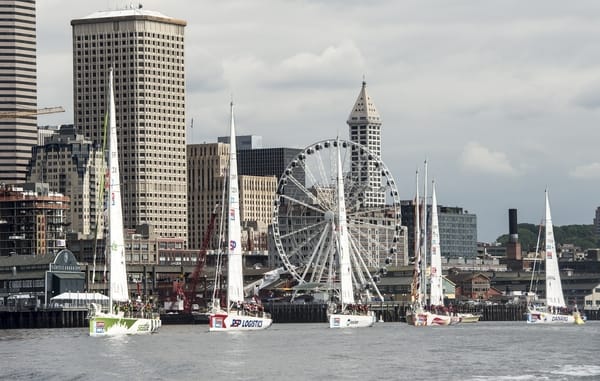
This year’s course is divided into 14 separate legs over 11 months. Boats stop for several days at the end of each leg. The race started in England last August and ends there in July.
About 1,500 men and women of assorted ages, nationalities and professional backgrounds applied to join this year’s race. Roughly half dropped out before the starting gun. Some did so after rethinking the idea of spending days or months with a dozen or so strangers in a small boat in weather that is often too hot, too cold, or too wet. Or two out of three.
Others failed to survive an intensive four-week training session that Clipper runs in England and Australia. The course teaches sailing basics and safety-at-sea lessons in at-sea conditions, which among other facts of life can mean living days on end in a boat heeling 45 degrees (leaning 45 degrees from perpendicular) while hobby horsing up and down into oncoming waves.
The training session is run as a no-nonsense boot camp since the event is not without risk. Each boat has a paid, professional skipper who is responsible for enforcing safety rules, but accidents happen. There have been two deaths in this race, the first fatalities in the two decades the Clipper race has been run.
“I’m doing everything I can to make this race safe,” insists Sir Robin Knox-Johnston, the grey bearded co-founder of Clipper Ventures and, at age 76, the public face of the event. He’s exasperated with the fatal accidents and pounds the table with his fist during an interview. “The sea is a dangerous place. They’ve got to understand that.”
He would know. To say that Robin Knox-Johnston is a legend in the sailing world is to understate the case by half.
In the 1960s, a London newspaper offered £5,000 to the first person to sail around the world, solo and without stopping. Nine sailors tried it. Knox-Johnston, 30 years old, was the only one to finish. He did it in 1969, finishing after 312 days in a traditional 44-foot teak ketch built in India. It was the maritime equivalent of being the first to summit Mt. Everest. He gave his prize money to the family of a fellow competitor, Donald Crowhurst, who started the race, suffered mental collapse and committed suicide at sea.
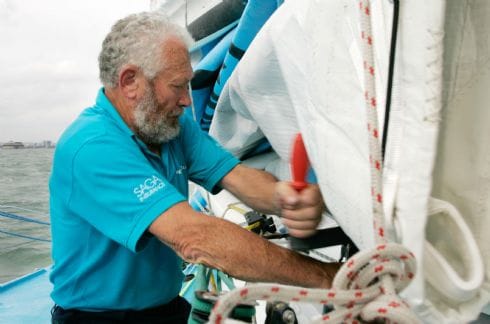
Since then, Knox-Johnston has made three more circumnavigations. In 1994, working in tandem with Peter Blake, he set the speed record for sailing non-stop around the world, finishing in 74 days. In 1995, he was knighted by the Queen. Last November, at age 75, he raced solo across the Atlantic, finishing third in his boat class.
To the average sailor, spotting Sir Robin on a marina dock is akin to a weekend hiker coming across Sir Edmund Hillary on a mountain trail.

Yacht IchorCoal in Seattle. Photo Credit: Clipper Media
The Clipper fleet moored in Bell Harbor marina in Seattle’s Elliott Bay for several days this week while the boats changed crews, re-provisioned, made repairs and conducted public tours. The boats departed Thursday, conducting man-overboard safety drills in Elliott Bay before heading north in Puget Sound and west to the entrance of the Strait of Juan de Fuca, where the start of the next race leg begins.
Aboard a boat named IchorCoal is Larry Garner, a 68-year-old retired defense industry executive from Liberty Lake, Washington, near Spokane. After taking beginner’s sailing courses, Garner spotted a Clipper race ad in a sailing magazine.
“I told my wife, ‘That’s something I’d really like to do.’ She said, ‘Why don’t you do it?’”
He took Clipper’s training course in England. “It’s very physical. They throw everything at you and don’t let you get away with anything,” he says. “We learned to cook, sleep, clean and do everything else at 45 degrees. I didn’t get seasick, but some did.
Garner knows that his boat, sponsored by a South African coal mining company, is the vessel where both crew deaths in this race occurred. Last September, Andrew Ashman, a 49-year-old British paramedic, was knocked unconscious off the Portuguese coast while helping to reduce sail as the wind freshened. Efforts to revive him failed.
Then, earlier this month, while racing across the North Pacific from Qingdao, China, to Seattle, 40-year-old Sarah Young, a British business owner, was swept overboard at night. She had failed to clip on a tether attached to her safety harness, a cardinal rule for offshore sailors. Her crew mates recovered her body. With several days remaining before landfall, she was buried at sea. A memorial service was held when the boats reached Seattle.
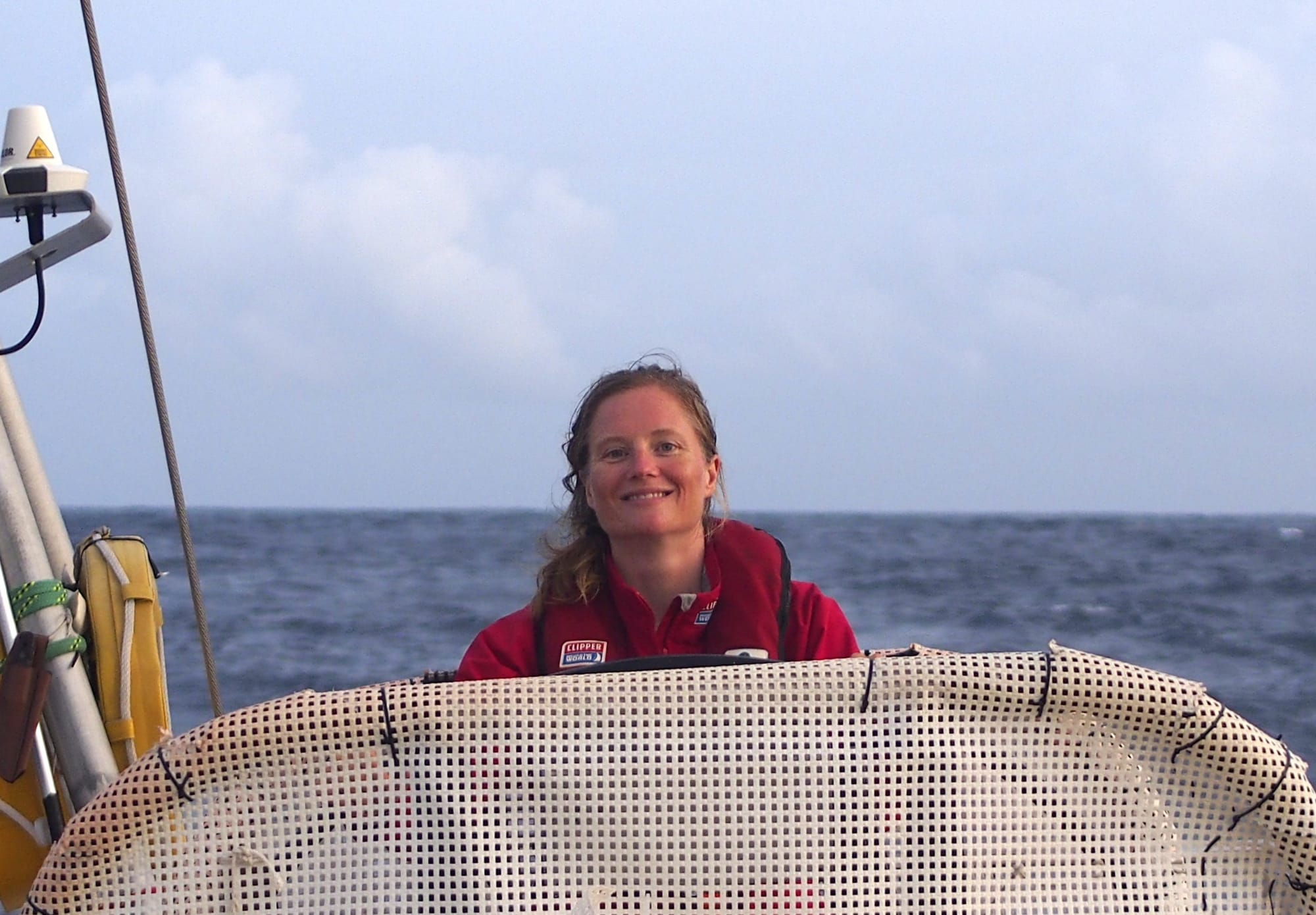
“She knew the drill,” says Garner. “We have a very clear protocol. When coming up from below, before your foot hits the deck, you tether on.”
Faced with twin tragedies, Knox-Johnston replaced IchorCoal’s skipper in Seattle but kept him on Clipper’s staff ashore. “I took him off the boat,” Knox-Johnston says. “If there’s one more accident, his reputation is finished. It would no longer be a coincidence. It’s just too risky.”
“I’m going to have to get tougher,” he adds, firmly. “If a crew member doesn’t tether on, they’ll get a warning from the skipper. A second time and I’ll cancel their contract.”
Garner said earlier this week that he’s isn’t bothered, though he hadn’t yet met IchorCoal’s replacement skipper. “I feel very confident with everyone I’ve sailed with in this program.”
From Seattle, the boats race to Panama, transit the Panama Canal, then start a second race, finishing in New York City. Going around Cape Horn at the tip of South America, a traditional stormy landmark for circumnavigators, would extend the race schedule beyond a year. It’s also approaching the middle of the Southern Hemisphere winter. Not a time any sailboat wants to deal with weather at Cape Horn.
Garner actually expects sailing conditions on his leg to be pleasant, with uncomfortably hot weather in Central America the only downside. “They’re calling it the champagne cruise,” he says.

Yuko Kikuchi. Photo Credit: Clipper Media
That’s a sharp contrast from the earlier crossing to Seattle from China, which was far from pleasant. Yuko Kikuchi was aboard Mission Performance. A 40-year-old woman with modest sailing experience who works at her family-owned homebuilding firm in Seattle, she was facing mid-life issues.
In 2011, the catastrophic Japanese tsunami that destroyed the nuclear power station at Fukushima devastated her nearby hometown of Ishinomaki. A year later, her father took ill. Kikuchi flew from Seattle but he died before she arrived. Her job, home construction in a city in the midst of a major building boom, is pressure-packed.
“I needed to do something for myself,” she explained, sipping hot tea in a coffee bar on the Seattle waterfront. She decided to go to sea. “I always wanted to cross a big ocean.”
She signed up for two of the Clipper race’s most reliably difficult routes in terms of weather: The Indian Ocean between Cape Town, South Africa and Western Australia, and the 5,900-mile North Pacific route from China to the U.S. West Coast.
The 28-day crossing from Qingdao to the Washington coast was unusually stormy. “There were a few days of grace” in the early going, as the yachts slalomed through the fishing fleet in the Yellow Sea and around southern Japan, she said.
Then, as the fleet headed east, the boats were hit with a series of low pressure weather fronts. “Constant 35- to 40-knot winds,” says Kikuchi. “It was really tough.”
The 70-foot yachts, designed by British naval architect Tony Castro and built in China, are identical. They are racing machines, designed for speed. Creature comforts are basically nil.
Kikuchi and the 13 other Mission Performance crew members steered the boat, raised, lowered and trimmed sails day and night, cooked meals, cleaned toilets, repaired sails with a sewing machine and did maintenance, all the while helping to keep the boat moving as fast as possible around the clock.
On deck, there’s no place to hide from the waves that regularly wash over the boat. Crew quarters are cramped with a major portion of the below-deck space dedicated to storage of spare sails. Sleeping bunks are narrow pieces of canvas lashed to aluminium frames with only enough for half the crew. This means crew members alternate sleeping in the same bunk, a system known as “hot bunking.”
Food is pedestrian: a lot of pasta and mashed potatoes, Kikuchi says. Aboard Mission Performance, the crew member on galley duty each day baked two loaves of bread, which provided French toast every morning for breakfast. Alcohol is verboten. Cellphones were surrendered to the skipper at the start of the race.
Kikuchi describes the routine on the Pacific crossing: “We were four hours on watch and four hours off. I like to sleep eight hours straight, so it was hard. You get up at night, your foul weather gear is soaking wet, you get up to the deck, the wind is blowing, you see the swells coming into the cockpit. Some nights it’s so cold you take your turn at the helm and then go down to the galley for 30 minutes to try and get warm.”
Kikuchi confesses that during the cold Pacific crossing, the crew fantasised about turning south and stopping at Hawaii. “We talked about that a lot,” she says with a laugh.
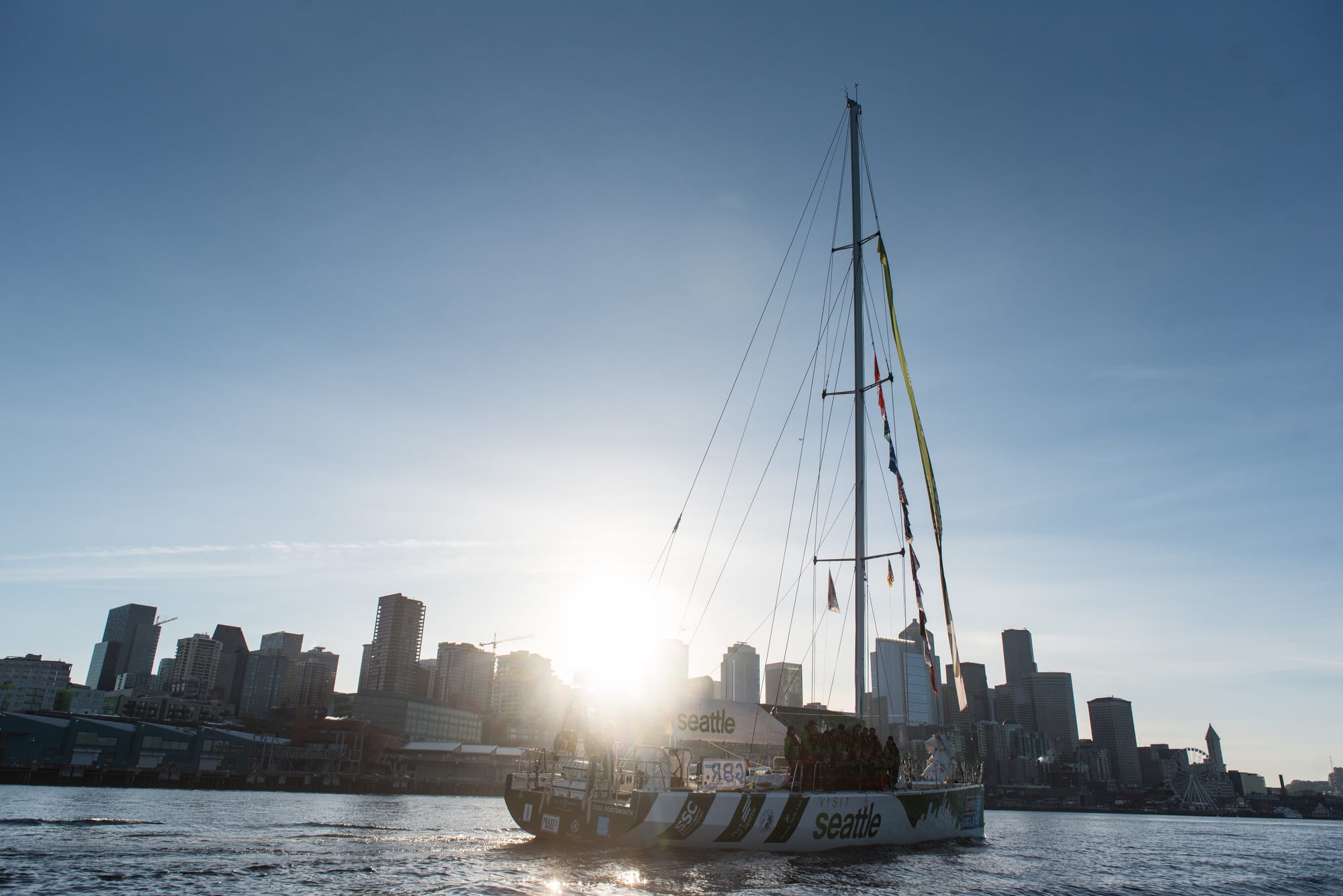
The idea of an arduous ocean sailing race crewed by people with mixed sailing skills dates from 1995, when Knox-Johnston teamed with William Ward, a sports entrepreneur and property developer, to form Clipper Ventures. They figured there was money to be made in providing a sports platform for global sponsorships, similar to what’s been done by football and rugby clubs.
Clipper would sell the idea of teamwork and leadership in a potentially hostile environment. They believed young, middle-aged and retired people looking for competition and physical challenge would pay a pretty penny to participate in a marathon yacht race. Especially one whose spokesman is Britain’s foremost living maritime hero.
“We had no idea what we were getting into,” Knox-Johnston admits.
The idea has paid off. A full time work force of 70 is based at Clipper headquarters in London. About 20 staffers are deployed to each port where the boats call. Knox-Johnston and Ward own 90 per cent of the company. “We’ve had a good run. I’m not driving a Rolls Royce. We make enough,” he says without disclosing annual revenue.
Fees paid by crew members come close to covering the costs of the race. Money from corporate sponsors and cities hosting the yachts cover a variety of other expenses, such as subsidizing crew members who can’t afford the steep fees. During this cruise, IchorCoal has a South African young person aboard on each leg. The youngsters come from townships where HIV-AIDS is rampant.
San Francisco has hosted the Clipper fleet on the West Coast in previous races. Seattle’s successful bid this year was engineered by the Seattle Sports Commission.
Seattle’s sponsorship included displaying the logo VisitSeattle in prominent green letters on the mainsail and topsides of one of the yachts along with a silhouette of the Space Needle and city skyline. Alas, the boat’s racing performance has been less handsome. It lags in the standings.
“The city did a very good job,” Knox-Johnston says. “They ticked all the boxes.” Will Clipper schedule Seattle for the 2017-18 race? “We need to sort out the finances,” he says, hinting that San Francisco remains a possibility the next time around.
A crew berth for the entire race around the world costs the participant $72,000. A total of 103 have made that commitment this year. Garner is paying $8,500 for the Seattle-Panama-New York race, plus the four-week training course. Kikuchi’s bill for two race legs comes to roughly $17,000.
All told, some 4,000 people of various ages and nationalities have crewed on Clipper yachts during the nine previous races. One-third of this year’s boat crews are women, as are two of the professional skippers. The youngest crew member is 18, the oldest 74. About half are British but 43 countries are represented in the 690-member crew pool.
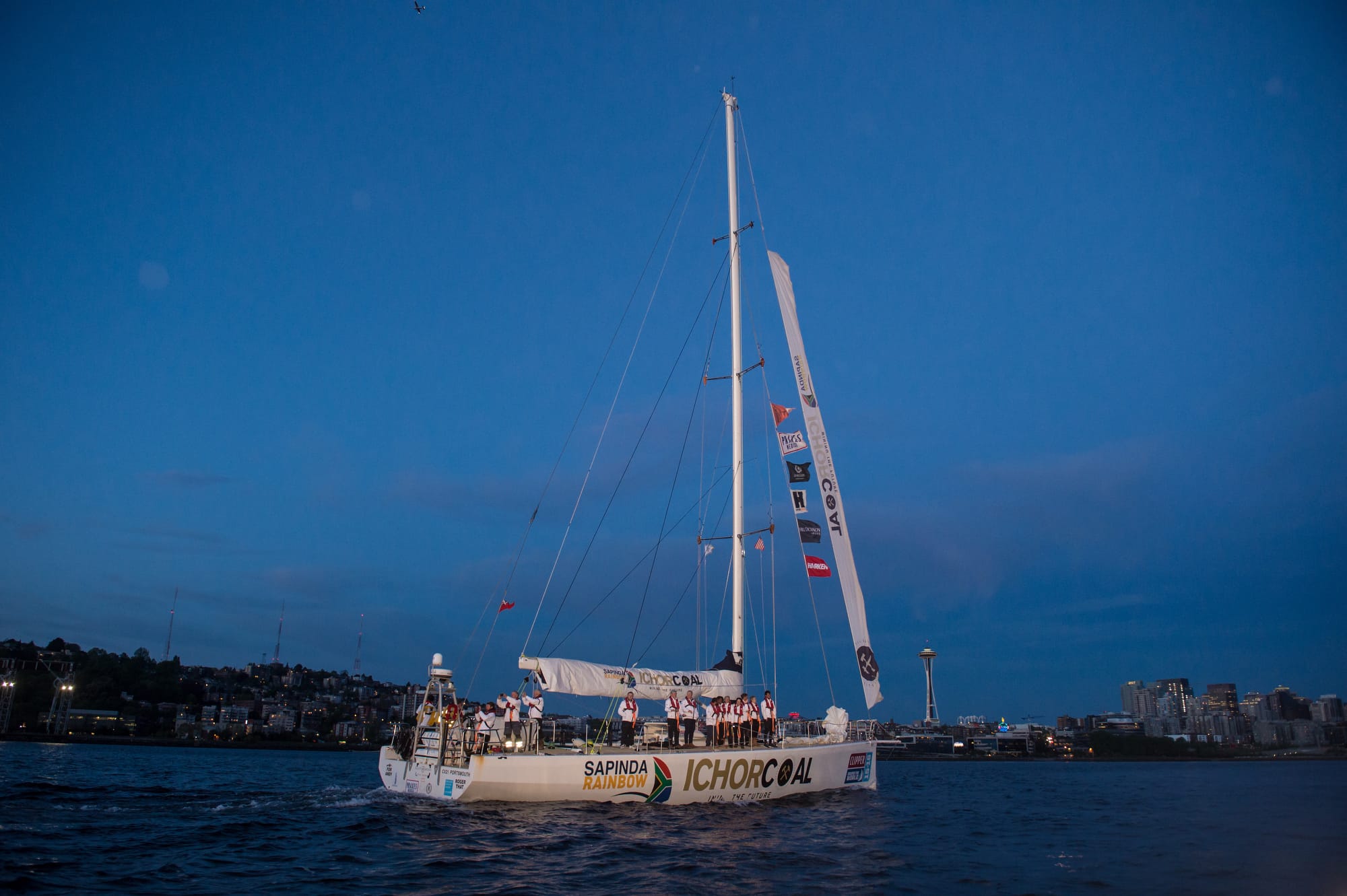
Was it worth it, Kikuchi is asked. “Surprising to say, I had a really good time, she replies. “Crew morale was high. Every afternoon we all got together and talked about problems on the boat, even little ones. We called it ‘Happy Hour’”.
Example: At one point during the Indian Ocean leg, the Mission Performance crew realized small, but potentially dangerous, things were going wrong before the end of a watch. “We came to the conclusion that we were getting lazy, losing focus, because our watch was ending, Kikuchi says. “We talked about it and we agreed that we needed to keep our attention up until the new watch comes on deck to relieve us. Then we can go below and relax. Solving that was very satisfying.”
Knox-Johnston beams when he hears the story and asks for a sheet of note paper to make a note. “That’s wonderful. I need to remember that,” he says.
Kikuchi says she’s readjusting to life ashore and spending considerable time catching up with email. The Mission Performance crew has been talking about a reunion, maybe another adventure trip.
“I’d like to sail someplace,” Kikuchi says. “Someplace warm, so I don’t have to worry about hypothermia.”
Follow the individual boats in the Clipper race in real time on this map. Robin Knox-Johnston documented his epic 1969 circumnavigation in a classic yachting memoir, A World of My Own. Donald Crowhurst’s tangled life, ending with suicide at the end of the 1969 round the world race, is captured in a riveting book, The Strange Last Voyage of Donald Crowhurst, by Nicholas Tomalin and Ron Hall. Crowhurst is the subject of a feature film, Deep Water, scheduled for release this year. Colin Firth and Rachel Weisz are the stars.


